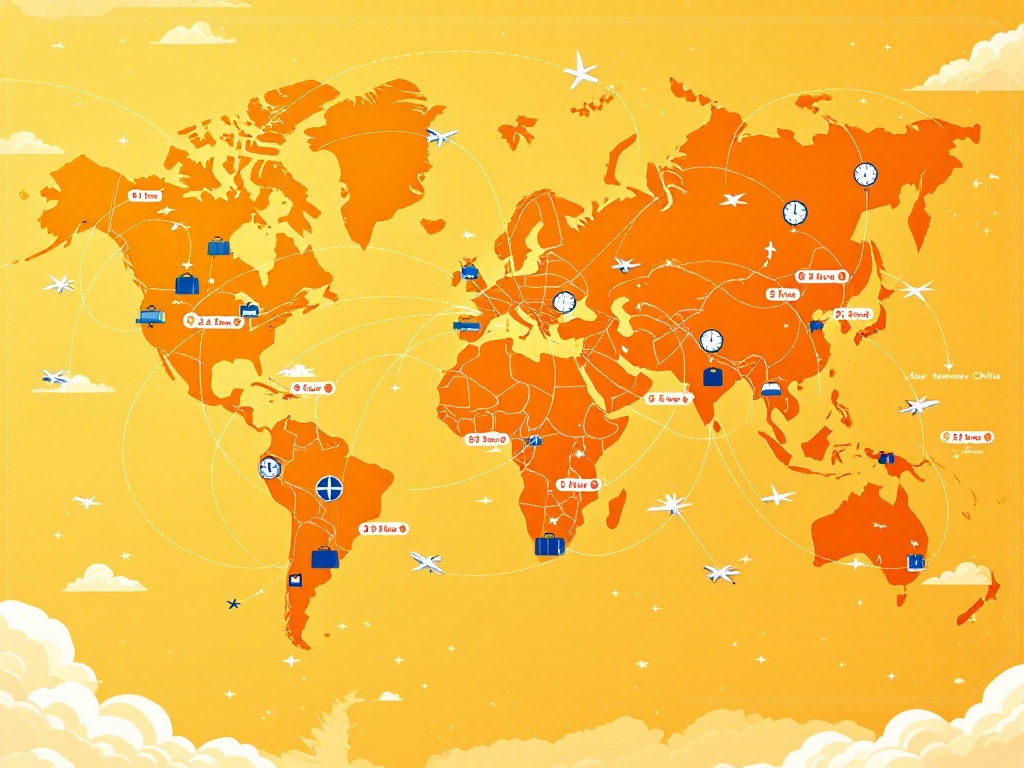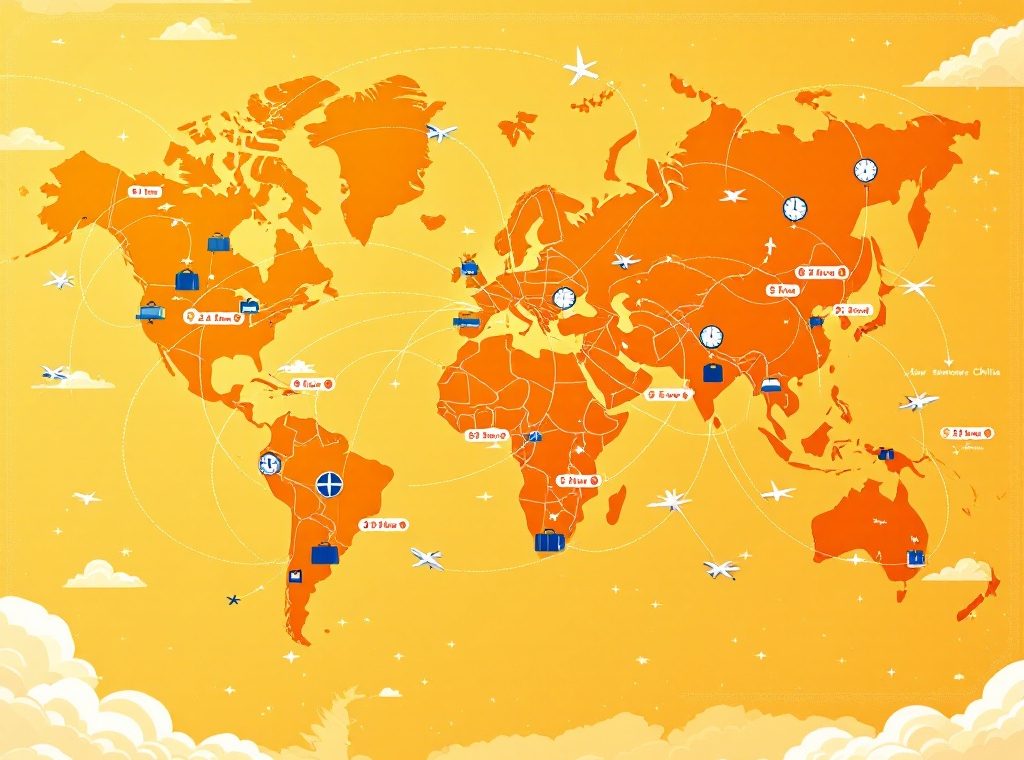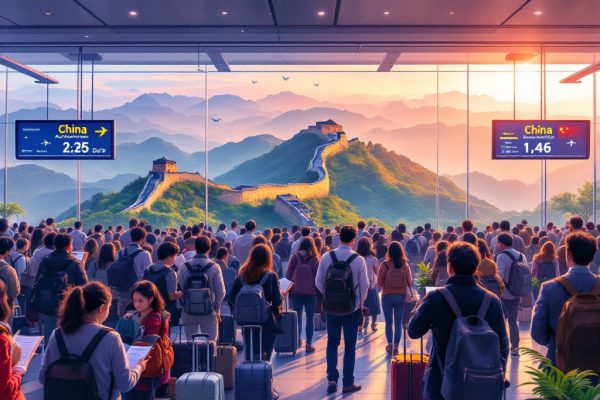How Long Does It Take to Travel to China? Estimating Travel Time and Layover Tips
Planning your dream trip to China? Flights to China can take up to 30 hours or more depending on layovers and your origin city. Learn how flight paths, weather, and even air traffic control can impact your travel time. Discover how to minimize jet lag by strategically planning your itinerary and using flight aggregators to find the best deals. This guide provides expert tips on navigating airport procedures, managing layovers, and ensuring a smooth, stress-free journey to China. Start planning your adventure today!
Important information

- Flights to China can take over 30 hours depending on layovers and your starting point.
- Travel time includes airport procedures, potential delays (weather, air traffic), and time zone changes.
- Non-stop flights are faster but often more expensive than connecting flights.
- For international layovers, allow 3-4 hours minimum for transfers, security, and potential visa requirements.
- Use flight aggregators to compare routes and prices, and book in advance for better deals.
Estimating Travel Time to China
Planning a trip to China? Direct flights offer the fastest travel time, but many routes include layovers, which can significantly extend your journey—sometimes up to 30 hours or more. Your total travel time also depends on the origin city. A flight from Los Angeles to Beijing will naturally take longer than one from Seoul. Remember to factor in airport procedures like check-in, security, and boarding, as these add to the overall duration. Unexpected delays due to weather or air traffic control can also occur. Crossing multiple time zones can make your trip feel even longer, so plan accordingly to minimize jet lag.
Understanding Travel Duration and Distance
Flight duration to China depends on the distance between airports, with longer distances resulting in longer flights. However, several other factors can influence your total travel time. These include: air traffic control delays, weather conditions such as storms, and flight paths, as sometimes a direct route isn’t the fastest option.
Factors Affecting Flight Duration and Punctuality
Several factors affect flight times. Weather conditions, such as storms and strong winds, can cause delays, increasing the overall duration. Air traffic congestion also contributes to delays. The chosen flight path plays a significant role; longer routes naturally lead to longer travel times. Layovers, depending on their length, further increase the total time spent traveling. Customs and immigration procedures add extra time. Finally, the airline’s specific schedule is a contributing factor.
Weather conditions, such as storms and strong winds, can cause delays and increase the overall duration.
Air traffic congestion contributes to delays.
The chosen flight path plays a significant role; longer routes naturally lead to longer travel times.
Layovers, depending on their length, further increase the total time spent traveling.
Customs and immigration procedures add extra time.
The airline’s specific schedule is a contributing factor.
Planning Your Flight Itinerary
Planning your trip to China starts with choosing the right flight. Consider whether a non-stop flight or a connecting flight better fits your schedule. Use flight aggregators to compare routes, airlines, and prices, balancing departure and arrival times with layover durations and overall travel time. Booking in advance often secures better options and deals, reducing travel stress and saving valuable time.
Non-stop Flights
While non-stop flights offer the quickest travel time, they may be more expensive. They are ideal for minimizing travel time and reducing the risk of delays or missed connections.
Connecting Flights
Connecting flights can be more budget-friendly, sometimes being the only available choice. However, they come with the risk of delays and potentially missing connecting flights, increasing overall travel time.
Think about your preferred departure and arrival times, factoring in the time needed for check-in, security, and boarding.
Booking your flight in advance often secures better prices and a wider selection of flights.
Utilize flight aggregators like Skyscanner, Google Flights, and Kayak. These tools compare airlines and routes, helping you find everything from non-stop journeys to connecting flights with convenient layovers.
Choosing Between Non-stop and Connecting Flights
Non-stop Flights
Non-stop flights offer the fastest travel experience, minimizing your overall journey time. This makes them ideal for travelers prioritizing speed and convenience.
Connecting Flights
Connecting flights, while often cheaper, involve layovers that extend travel duration. The potential cost savings come with the risk of missed connections due to delays, impacting your final arrival time.
Flight Schedule Considerations and Booking Tips
Flight schedules significantly influence both ticket prices and seat availability. Booking your flights well in advance, especially during popular travel periods, often helps you secure better deals on fares.
Mid-week flights are typically less congested and friendlier to your budget. They offer a more relaxed travel experience compared to weekend flights.
To effectively compare airlines and their respective flight schedules, make the most of online flight comparison websites. These platforms allow you to see various options in one place, making informed decisions easier.
Factor in your arrival time at your destination to minimize the potential impact of jet lag. Choosing a flight that aligns better with your body clock can make a noticeable difference in adjusting to a new time zone.
Using Flight Aggregators for Best Travel Routes
Flight aggregators gather data from various airlines, providing a wide selection of routes and schedules that streamline trip planning. These tools allow travelers to compare prices and find the best itineraries, leading to informed decisions that balance cost and convenience.
Managing Flight Connections and Airport Procedures
Minimum Connection Times (MCTs) are crucial for smooth transfers. These are the shortest connection times allowed by airlines and vary depending on the airport, the airlines involved, and whether your flight is domestic or international. Always check the specific MCT with your airport and airline.Navigating airport procedures is essential for a smooth journey from boarding pass to baggage claim. First, acquire your boarding pass, either digitally or at the counter. Next, proceed through security, keeping in mind regulations for liquids and electronics. Then, locate your gate and wait for boarding. For checked luggage, ensure your bag tags are correct. Finally, upon arrival, retrieve your luggage at baggage claim.Flight disruptions and cancellations can be inconvenient. If your flight is affected, contact your airline immediately for rebooking assistance. Familiarize yourself with their compensation policies for meals, hotels, and alternative transportation. Travel insurance provides valuable protection against unexpected expenses, so consider purchasing coverage before your trip.
Understanding Minimum Connection Times (MCT)
Minimum connection times (MCTs) ensure seamless travel by representing the shortest connection time between flights. This allows for comfortable transfers between gates, terminals, or even airports. Factors like airport layout and security procedures influence these times. MCTs are airport-specific and tailored to your itinerary. Airlines use MCTs for scheduling, so booking shorter connections isn’t usually possible. For specific MCT details, check the airport’s website or contact the airline.
Airport Procedures: From Boarding Pass to Checked Luggage
Present your passport and flight confirmation at the airline counter to receive your boarding pass, which indicates your seat and gate.
Drop off any checked luggage, keeping in mind airline size and weight restrictions.
Proceed to security, where you and your carry-on items will be screened.
Locate your gate using airport signage and await the boarding announcement.
Dealing with Flight Disruptions and Cancellations
In case of flight disruptions or cancellations, immediately contact your airline for rebooking or a refund. They often provide alternative flights and may cover meals and accommodations during extensive delays. Also, review your travel insurance policy to understand its coverage for such situations. Travel insurance offers valuable protection against unforeseen travel hiccups.
Layover Tips and Best Practices
Planning international flight layovers requires more attention than domestic ones. While two to three hours is usually sufficient for domestic connections, international itineraries often demand at least three to four hours. This buffer accommodates deplaning, navigating larger international terminals, clearing security, and boarding your next flight. Immigration and customs are typically handled at your final destination. However, some countries require transit visas even for layovers, so research visa requirements based on your nationality and layover location.
Streamline Your Layover
- Utilize online check-in and download your boarding pass to save time at the airport.
- Pack a well-organized carry-on with essentials like medications, snacks, and entertainment.
- Stay updated on gate changes and flight schedules via airport displays or airline apps.
- Consider accessing an airport lounge for a more relaxing experience.
Longer Layover Activities
A longer layover, perhaps six hours or more, might allow for a brief city exploration. This depends on the city’s proximity to the airport and available transportation. Remember to factor in travel time to and from the city center, potential immigration processes, and possible delays. Research local transportation and attractions beforehand.
Crucially, incorporate extra time for your return trip to the airport.
Recommended Layover Times for International Flights
A two to three-hour layover is typically sufficient for international flights, allowing ample time for airline transfers and immigration processing. However, longer layovers may be needed at larger airports or when connecting with different airlines. To cushion against potential delays, a more generous buffer is often advisable.
Handling Immigration and Customs During Layovers
International layovers, especially in countries like China, often require 30 to 60 minutes for immigration and customs procedures. Factor this into your travel plans. Visa requirements vary based on your nationality and layover duration. Check your eligibility for a transit visa or if a standard visa is required. Returning to the airport at least two hours before your connecting flight is essential. However, allowing extra time provides a buffer against unexpected delays in immigration and customs, minimizing travel stress.
Plan for immigration and customs. International layovers, particularly in countries like China, require 30 to 60 minutes for immigration and customs procedures.
Check visa requirements. Visa requirements depend on your nationality and the duration of your layover; check your eligibility for a transit visa or if a standard visa is necessary.
Return to the airport early. Returning to the airport at least two hours before your connecting flight is crucial, but building in extra time provides a cushion against unforeseen delays.
Minimizing Stress with Layover Tips
Traveling with layovers can be challenging, but ample connection time minimizes stress. Airport amenities, including lounges, restaurants, and shops, make waiting more enjoyable. Before you go, check visa requirements for your layover destination. A well-packed carry-on with snacks and entertainment also enhances comfort. Lastly, keep an eye on boarding times and gate changes to avoid missing your flight. Here’s how to make your layover experience smoother:
Secure a comfortable connection time. Having ample time between flights reduces the pressure of potential delays. This allows you to navigate the airport, locate your gate, and relax without rushing.
Take advantage of airport amenities. Many airports offer various amenities to make your layover more pleasant. Explore lounges, restaurants, shops, or simply relax in designated waiting areas.
Check visa requirements. Depending on your nationality and layover destination, you might need a transit visa. Research the specific visa regulations well in advance to avoid any complications.
Pack a well-equipped carry-on. Having essential items in your carry-on can significantly improve your layover experience. Pack snacks, entertainment (books, movies, music), and any necessary medications.
Monitor boarding times and gate changes. Stay informed about any updates regarding your connecting flight. Pay attention to announcements and check display screens regularly to avoid missing your flight.
Is a 6-Hour Layover Enough to Explore the City?
A six-hour layover may seem like plenty of time for sightseeing. However, considering immigration, customs, and travel time to and from the airport, you’ll have less time than you think. Factoring in a recommended two-hour pre-flight airport return and estimating immigration and customs to take approximately one hour, you’re left with only about three hours to explore.


















